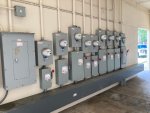JasonCo
Senior Member
- Location
- Houston, Texas
Yep 100%. 1 service with 3 service disconnects. All adjacently grouped. The way this Mike Holt book explains the 230.2, I like the terminology that was used. Instead of the NEC book saying:
They word it by saying
Because your service starts back at the service point. Which in my case is at the weather head traveling up the Utility pole, where the wires are splices with POCO's transformer wires. So 1 service "Service drop/Service lateral" per building unless permitted by A - D.
230.2 A building or other structure served shall be supplied by only one service unless permitted in 230.2(A) through 230.2(B).
They word it by saying
230.2 A building can only be served by one service drop or service lateral except as permitted by (A) through (D).
Because your service starts back at the service point. Which in my case is at the weather head traveling up the Utility pole, where the wires are splices with POCO's transformer wires. So 1 service "Service drop/Service lateral" per building unless permitted by A - D.
Last edited:



